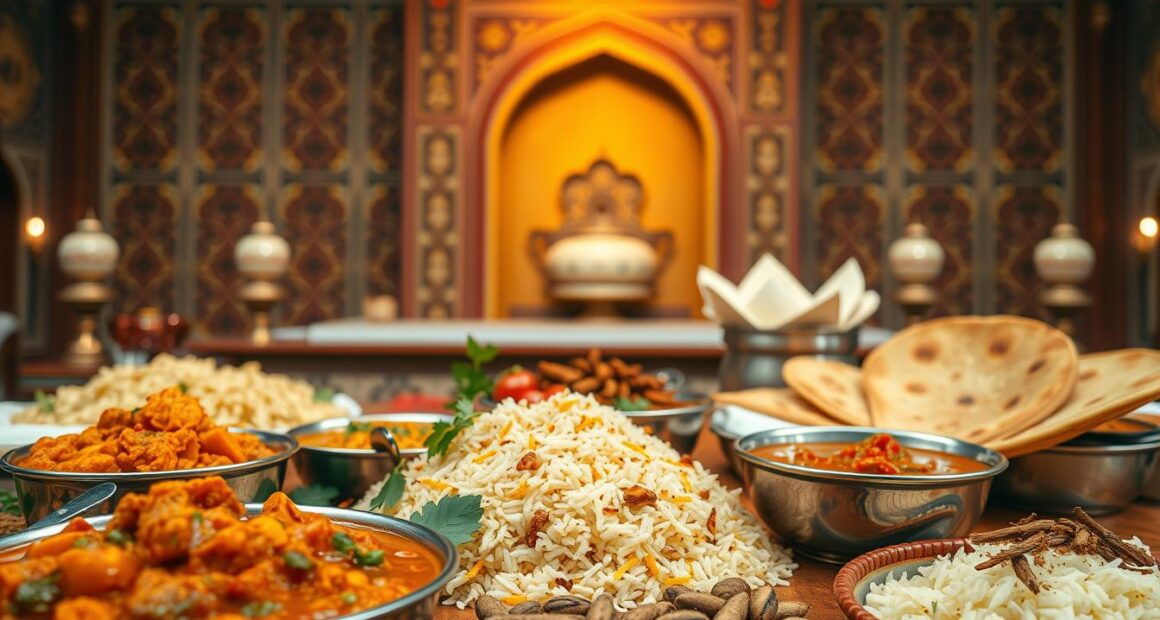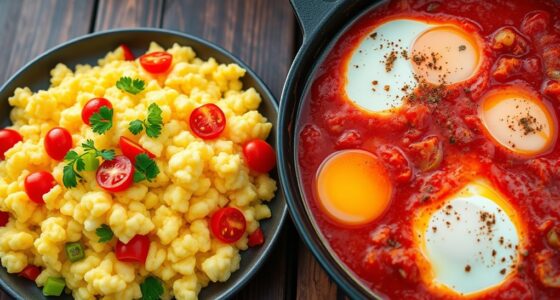Imagine a kaleidoscope of colors, aromas, and flavors swirling around you—a feast for not just the stomach, but for the soul. Indian cuisine is more than just food; it’s a tapestry woven through centuries of history, tradition, and passion. Each dish tells a story, a narrative filled with vibrant spices, rich sauces, and heartfelt hospitality. As you embark on your culinary journey, consider how food has always brought people together, whether at family gatherings, street-side stalls, or trendy restaurants. The feeling is universal—a shared smile over a plate of Butter Chicken or the warmth of a homemade Masala Chai. Let’s explore the 10 must-try delights of Indian cuisine, where every bite holds the promise of heartfelt connection and unforgettable flavor.
Key Takeaways
- Indian cuisine showcases a glorious blend of flavors and spices.
- Each region of India offers unique and diverse dishes.
- Butter Chicken is a universally loved dish, often a gateway into Indian food.
- Samosas provide a crunchy, flavorful taste experience, enhanced by various chutneys.
- Biryani comes in many regional varieties, making it a must-try dish for any food lover.
- Authentic Indian food plays a central role in cultural celebrations and traditions.
Introduction to Indian Cuisine
Indian cuisine showcases a diverse range of cooking styles and ingredients, shaped by the country’s vast climates, soil types, cultures, and religions. Each region presents unique flavors and traditions, making it a culinary adventure that has captured the hearts of food lovers around the globe. Traditional indian recipes often highlight the importance of local ingredients, including various grains, legumes, and colorful vegetables.
The use of indian spices is paramount in enhancing flavors, with turmeric, cumin, and coriander serving as key players in countless dishes. In northern India, rich dairy products complement hearty lentil-based stews, while the southern regions celebrate rice as a staple, often served alongside sambhar—a flavorful lentil dish. The introduction of aromatic spices and ingredients from across the world, such as potatoes and tomatoes, further enriches the cuisine.
This vibrant tapestry of flavors includes everything from enticing curries to irresistible street foods. In the coming sections, you will discover ten iconic dishes that represent the rich heritage and culinary creativity inherent in indian cuisine.
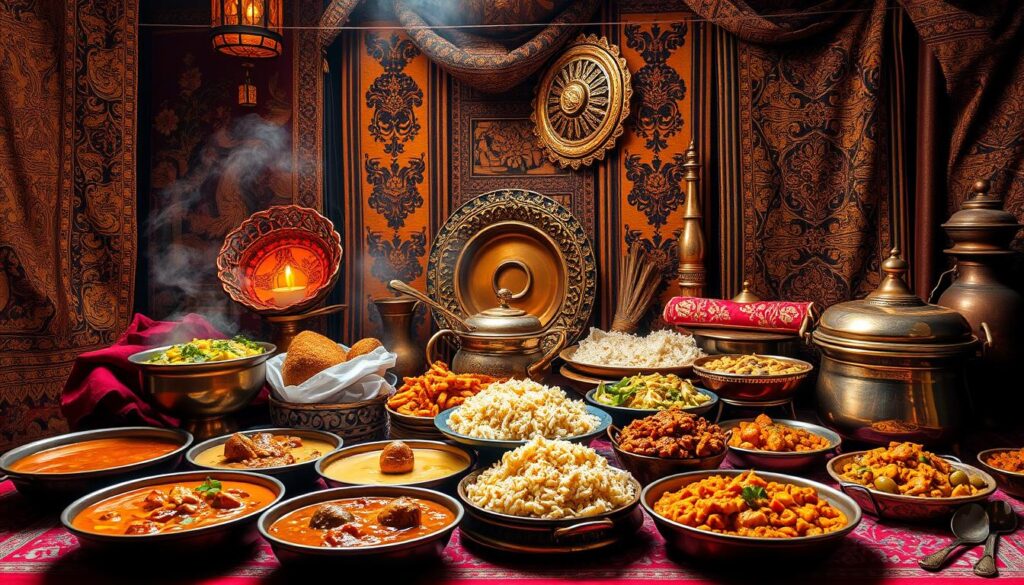
The Rich Heritage of Indian Food
Indian cuisine offers a captivating journey through history, deeply rooted in a diverse tapestry of regional influences. Over 5,000 years ago, the Indus Valley Civilization began cultivating spices like turmeric and pepper, laying the foundation for what would evolve into a vibrant culinary landscape. As you explore the best indian restaurants, you’ll discover how various cultures and ingredients blend to create the spicy indian food that is so beloved today.
Regional Influences on Flavors
India’s vast geography has given rise to distinct regional cuisines, each characterized by unique ingredients and cooking methods. In the north, you’ll find creamy gravies and buttery dishes dominating menus, while the south prioritizes rice and coconut. This diversity is reflected in a 60-40 ratio of creamy to coconut-based dishes across the regions. Persian influences introduced kebabs, accounting for about 15% of popular dishes, while Mughal cuisine’s rich sauces and use of nuts shape approximately 25% of modern recipes. The introduction of ingredients like chillies and tomatoes by European colonists transformed many traditional recipes, highlighting an evolution that continues to this day.
Ingredients That Define Indian Dishes
The heart of Indian cuisine lies in its ingredients. Staples such as rice, lentils, and an array of vegetables form the basis of countless meals. Spices like cumin, coriander, and garam masala are fundamental, adding depth and vibrancy to every plate. Tadka, the technique of tempering spices, is foundational in 70% of Indian dishes, elevating the flavors to new heights. As you experience these delightful combinations, you will understand why sharing meals remains a cherished cultural practice, observed in 85% of Indian social gatherings.
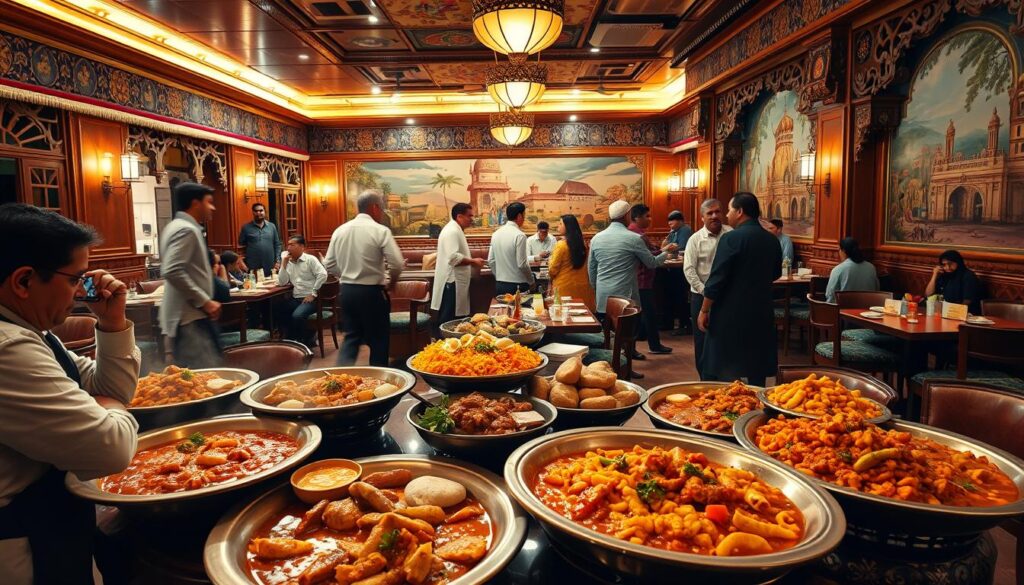
Top 10 Must-Try Indian Dishes
Exploring the world of indian street food presents a vibrant way to experience India’s diverse culinary landscape. Each dish you encounter offers a unique flavor profile and tells a story about its cultural significance. Here, you’ll dive into the top ten must-try indian dishes that epitomize the richness and variety of Indian cuisine.
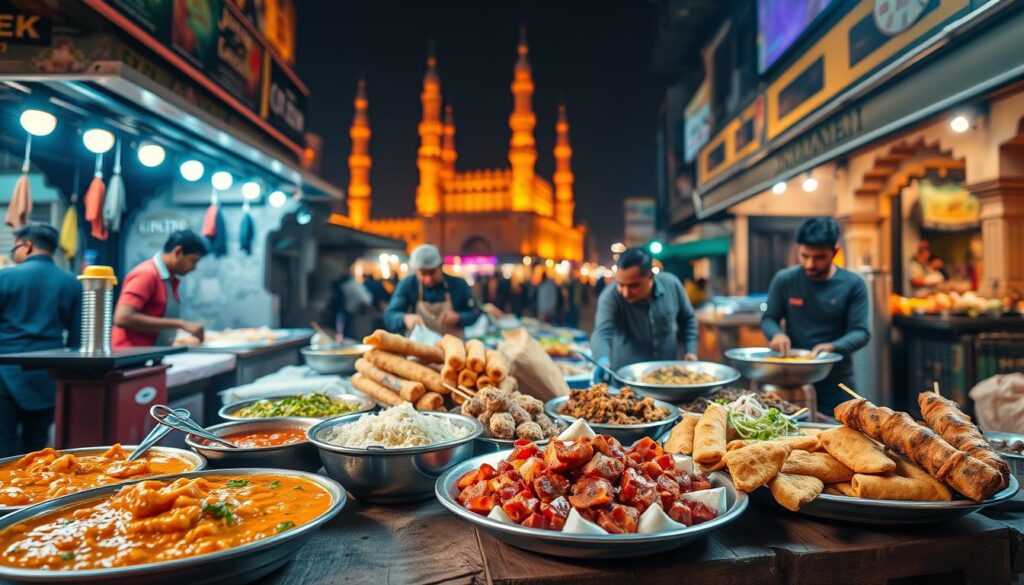
| Dish | Description | Cultural Significance |
|---|---|---|
| Butter Chicken | A creamy tomato-based curry with tender chicken pieces. | Beloved as a gateway dish for newcomers to Indian cuisine. |
| Biryani | Layered rice dish cooked with spices and marinated meat. | Hyderabad is famous for its iconic biryani, showcasing regional heritage. |
| Pani Puri | Crispy shells filled with spicy water, tamarind, and fillings. | A favorite among street food lovers, representing the essence of chaat. |
| Samosa | Golden pastries stuffed with spiced potatoes or lentils. | A historical appetizer reflecting trade influence in Indian culinary practices. |
| Dal Makhani | Rich dish made from black lentils and kidney beans. | Symbolizes the vegetarian tradition in Northern Indian cuisine. |
| Masala Dosa | Crisp crepe filled with spiced potatoes. | Commonly part of breakfast in South India, highlighting local dietary habits. |
| Tandoori Chicken | Chicken marinated in yogurt and herbs, cooked in a tandoor oven. | Represents traditional cooking techniques dating back thousands of years. |
| Chole Bhature | Spicy chickpeas served with fluffy fried bread. | A North Indian favorite, showcasing the popularity of vegetarian options. |
| Rogan Josh | Aromatic lamb or goat curry from Kashmir. | Exemplifies the rich spice heritage and culinary influences in Indian cuisine. |
| Gulab Jamun | Soft dough balls soaked in rose syrup. | Commonly enjoyed during festivals, symbolizing sweetness in Indian culture. |
These must-try indian dishes not only tantalize the taste buds but also reflect the deep-rooted traditions and diverse influences that shape the culinary landscape of India. Each dish invites you to experience a world brimming with flavors and stories, ensuring a culinary adventure unlike any other.
1. Butter Chicken: A Creamy Classic
Butter chicken, widely loved for its delightful combination of flavors, represents the essence of traditional Indian recipes. Originating from Delhi, this creamy butter chicken features tender pieces of chicken cooked in a velvety, spiced tomato-cream sauce. The magic happens during marination, where the chicken is soaked in a mixture that infuses it with flavor and tenderness. This dish stands out for its rich, creamy texture combined with the exciting spices characteristic of Indian cuisine.
What Makes Butter Chicken Unique?
The uniqueness of butter chicken lies in its preparation and flavor profile. To create the perfect dish,
you need:
- 500 grams (1.1 lbs) of boneless chicken, either thighs or breasts.
- ⅓ cup of Greek yogurt or hung curd for marinating the chicken.
- 600 grams (1.3 lbs) of fresh tomatoes, yielding about 3 cups of fresh tomato puree, or alternatives like canned tomato puree.
- A rich blend of spices, complemented by 28 whole cashews for that luxurious creamy texture.
Post-marination, cooking the chicken involves achieving an internal temperature of 164°F (74°C), sealing in all the flavors. This dish is often praised on social media, garnering 7.9K shares, highlighting its popularity.
Best Ways to Enjoy It
Your culinary journey with butter chicken wouldn’t be complete without the right accompaniments. This creamy delight shines alongside:
- Soft naan or roti, perfect for dipping.
- Basmati rice for a fragrant base.
- Fresh cucumber and onion salad for crunch.
For meal prep enthusiasts, leftovers can be stored for up to 3 days, allowing you to enjoy this flavorful dish more than once a week. The delightful interplay of spices and cream makes butter chicken a staple in every fan of traditional Indian recipes.

2. Biryani: The Aromatic Rice Dish
Biryani stands out as a rich and flavorful rice dish that embodies the essence of authentic biryani. This dish varies widely, reflecting the diverse regional influences of India. Each type brings its own unique character, making it essential to familiarize yourself with the various varieties of biryani before diving into cooking.
Varieties of Biryani You Should Know
- Hyderabadi Biryani: Known for its bold flavors and use of marinated meats, this biryani often features aromatic spices and layering techniques.
- Lucknowi Biryani: Milder in taste, it focuses on tenderness and rich, subtle spices.
- Kolkata Biryani: A unique variant that includes potatoes, which adds a delightful twist to the traditional recipe.
Tips for Cooking Perfect Biryani
Creating the perfect biryani involves understanding key indian cooking techniques that highlight the dish’s authentic flavors. Begin with marinating 1.5 lbs. of boneless chicken thighs in a mixture of yogurt and spices for at least an hour to enhance the meat’s tenderness and taste. Use 2 1/4 cups of uncooked basmati rice and soak saffron in warm water for added richness.
The cooking process requires precise timing. Begin by frying onions until golden and crispy, which typically takes around 15-20 minutes. Don’t overlook the par-boiling of rice for about 5 minutes before layering it over the marinated chicken in your pot. Finally, assemble everything and allow it to cook over low heat for approximately 10 minutes to ensure all aromas blend perfectly.
This culinary adventure not only caters to your taste buds but also provides a fulfilling experience of making authentic biryani that embodies the heart of Indian cuisine.

3. Samosas: Irresistible Snacks
Samosas stand out as one of the most beloved popular indian snacks. These crispy pastries boast a delightful crunch and are filled with various savory ingredients. Originating from ancient Persia, the samosa has evolved and become a favorite among many cultures. In India, they thrive as a staple in indian street food culture, widely sold at local stalls and food markets.
Different Fillings for Samosas
While the classic samosa filling consists of spiced potatoes and peas, you can find exciting variations. Here’s a quick look at some popular fillings:
| Filling Type | Description |
|---|---|
| Vegetable | Typically includes potatoes, peas, and spices. |
| Meat | Often filled with minced meat varieties, spiced to perfection. |
| Lentil | Features spiced lentils, offering a protein-packed option. |
| Sweet | Popular during festivals, these may include sweetened coconut or nut-based fillings. |
Best Dipping Sauces to Pair With
A perfect samosa experience isn’t complete without dipping sauces. Here are some popular accompaniments that elevate the flavorful snack:
- Mint Chutney – Refreshing and slightly spicy, a classic choice.
- Tamarind Sauce – Sweet and tangy, balancing the spices of the samosa.
- Yogurt Sauce – Creamy and cooling, providing a delightful contrast.
- Chili Sauce – For those who love an extra kick of heat.

4. Paneer Tikka: A Vegetarian Delight
Paneer Tikka is a stellar example of how vegetarian Indian dishes can amaze our taste buds. Comprising marinated paneer cubes that are grilled to perfection, this dish boasts a smoky flavor that often reminds one of traditional chicken preparations. The secret behind its rich taste lies in the careful selection of spices and cooking techniques, making it a popular choice among paneer recipes.
Cooking Methods for Paneer Tikka
Achieving that perfect Paneer Tikka requires a few accessible cooking methods. You can choose between grilling in an oven or using an air fryer. Here’s a quick overview:
| Method | Temperature | Duration |
|---|---|---|
| Oven | 430°F (220°C) | 8-10 minutes |
| Air fryer | 390°F (200°C) | 7 minutes (5 minutes + 2 minutes) |
Regardless of the method, marinating paneer with spices such as Kashmiri red chili powder, turmeric powder, and garlic paste will enhance its flavor. A good marinade can take about an hour for the spices to infuse properly, making the end dish even more delightful.
Serving Suggestions That Impress
When it comes to serving Paneer Tikka, creativity plays a key role. You can:
- Present it on skewers with a side of coriander chutney for dipping.
- Accompany it with fresh salads featuring sliced onions and bell peppers.
- Pair it with a spicy sauce or can even use it in wraps for a fun twist.
The versatility of Paneer Tikka makes it a standout contender among vegetarian Indian dishes. It’s a favorite at gatherings and social events, satisfying every guest and showcasing how paneer recipes can elevate your culinary repertoire.
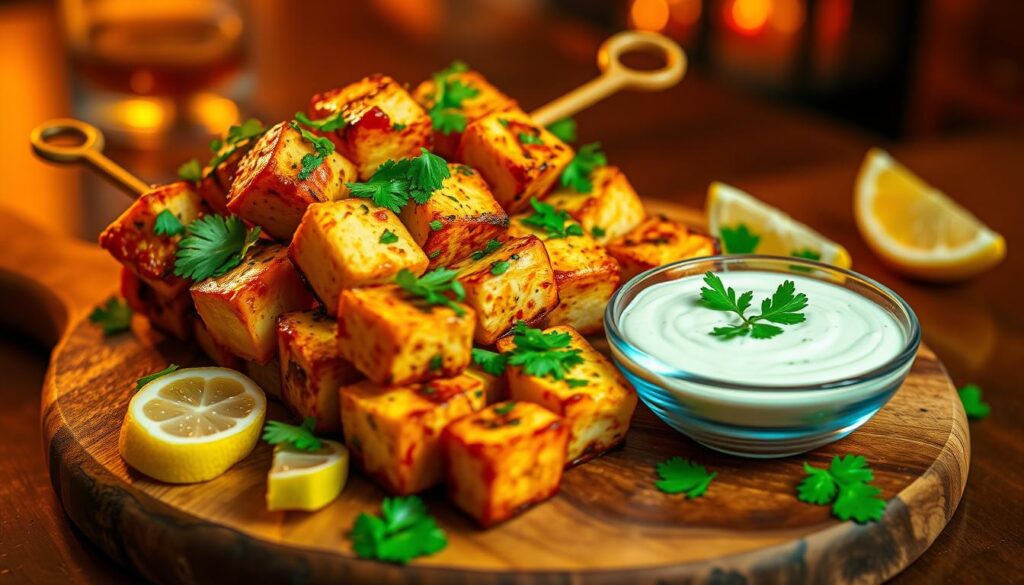
5. Masala Dosa: The Perfect Breakfast
Masala Dosa stands out as a celebrated traditional south Indian breakfast dish. This delectable food consists of a thin, crispy crepe made from a fermented batter of rice and lentils. Inside, you will find a flavorful filling of spiced mashed potatoes, bringing together crispy and soft textures in each bite. Many enjoy starting their day with this dish, making it a staple in South Indian kitchens.
What is a Masala Dosa?
Masala Dosa is more than just a breakfast option; it has become a timeless classic in South Indian culinary tradition. The preparation involves soaking rice and urad dal for hours, fermenting the mixture, and then grinding it into a batter. Place a ladle of this dosa recipe on a hot griddle, and within minutes, it transforms into a crisp, golden-brown masterpiece. Often served with sambar and coconut chutney, it truly embodies the heart of South Indian breakfast culture.
Accompaniments to Enhance the Experience
To amplify the pleasure of enjoying Masala Dosa, several accompaniments can be served. Traditional pairings include:
- Sambar: A rich lentil stew with vegetables that adds depth of flavor.
- Coconut Chutney: A refreshing dip made from grated coconut and spices, enhancing the dosa’s taste.
- Mint Chutney: For those who prefer a bit of zest, this spicy dip works wonders.
Celebrating World Dosa Day highlights the popularity of this dish, underscoring its cultural significance. Variations like Paneer Dosa, Spinach and Cheese Dosa, and Chocolate Dosa exhibit its versatility, appealing to both savory and sweet lovers. The communal aspect of preparing dosas invites friends and family, making it an experience as much as a meal.

6. Rogan Josh: A Flavorful Curry
Rogan josh is one of the most famous Indian curries, cherished for its rich flavor and inviting aroma. With its roots in Kashmiri cuisine, this dish consists of tender lamb or goat that is slow-cooked with a blend of vibrant spices, yogurt, and onions. The signature red hue is not just for show; it reflects the robust flavors that characterize this iconic recipe. If you’re looking to explore a rogan josh recipe, you’ll discover a delightful culinary experience that captures the essence of Indian cuisine.
Origins of Rogan Josh
This celebrated dish has a storied history, believed to have been introduced to India by Persian travelers. The name itself translates to “red heat,” referring to both the color of the dish and its spicy flavor profile. The use of high-quality lamb, particularly the shoulder cut, ensures a meltingly tender texture that is perfect for stewing. Over the years, various regions have added their unique twists, but the classic Kashmiri version remains a favorite among food enthusiasts.
Best Served With Which Sides?
Rogan josh shines when paired with warm naan or steamed basmati rice, which help to balance its rich flavors. For a complete meal, consider serving it alongside a side of raita, a cool yogurt-based condiment that complements the spices superbly. You might also enjoy a simple salad or some pickles to add contrasting textures to your plate. In a nutshell, pairing this famous curry correctly can elevate your dining experience significantly.

7. Chole Bhature: A Hearty Meal
Chole bhature is a beloved staple among traditional indian meals, known for its delightful combination of spicy chickpea curry and fluffy deep-fried bread. Originating from North India, this dish excites the taste buds with rich flavors and textures. With its unique spices and the satisfying bhature, you’ll find it hard to resist this hearty meal.
Exploring the Ingredients
The heart of the chole bhature recipe lies in its ingredients. Dried chickpeas, when used, require soaking overnight and slow cooking to achieve a tender texture. Alternatively, opting for canned chickpeas speeds up the process, making it convenient for a quick meal. The chickpeas are simmered in various spices, including cumin, chole masala, and garam masala, which form the flavorful curry.
The bhature dough is crafted from all-purpose flour, yogurt, and some leavening agents, allowing it to rise effectively. Frying the bhature at around 360 degrees Fahrenheit ensures they puff up beautifully, resulting in a crispy outer layer and a soft interior—a perfect complement to the chole.
Perfect Pairings with Chole
To elevate your chole bhature experience, consider pairing the meal with sides such as pickles, yogurt, and raw onions. The tartness of pickles and the creaminess of yogurt balance the spices, creating a delightful combination. With an approximate total time of 35 minutes to prepare and cook, this dish serves about 12 people, making it ideal for gatherings.

8. Tandoori Chicken: Smoky and Spicy
Tandoori chicken is a beloved dish in authentic Indian food, renowned for its smoky flavor and vibrant color. This iconic dish involves marinating chicken in a spiced yogurt mixture before cooking it in a traditional tandoor oven or a modern oven, providing that signature charred finish. The tandoori chicken recipe emphasizes the importance of marination for optimal flavor, making it essential to plan ahead for a truly delightful experience.
Cooking Techniques for Authentic Flavor
To achieve the best results with your tandoori chicken, consider the following cooking methods and tips:
- Marination Time: Ideally, allow the chicken to marinate for 6 hours to up to 48 hours. This enhances the flavors significantly.
- Oven Cooking: Preheat your oven to 375°F (190°C). Bake the chicken for about 30 minutes, flipping it midway through to ensure even cooking.
- Broiling: For a lightly charred finish, broil for 4-5 minutes. If the chicken doesn’t achieve the desired char, move the rack to the top and broil for an additional 1-2 minutes.
- Air Frying: Cook at 380°F (193°C) for approximately 18-22 minutes.
- Outdoor Grilling: Grill the chicken for 27 to 30 minutes, turning periodically.
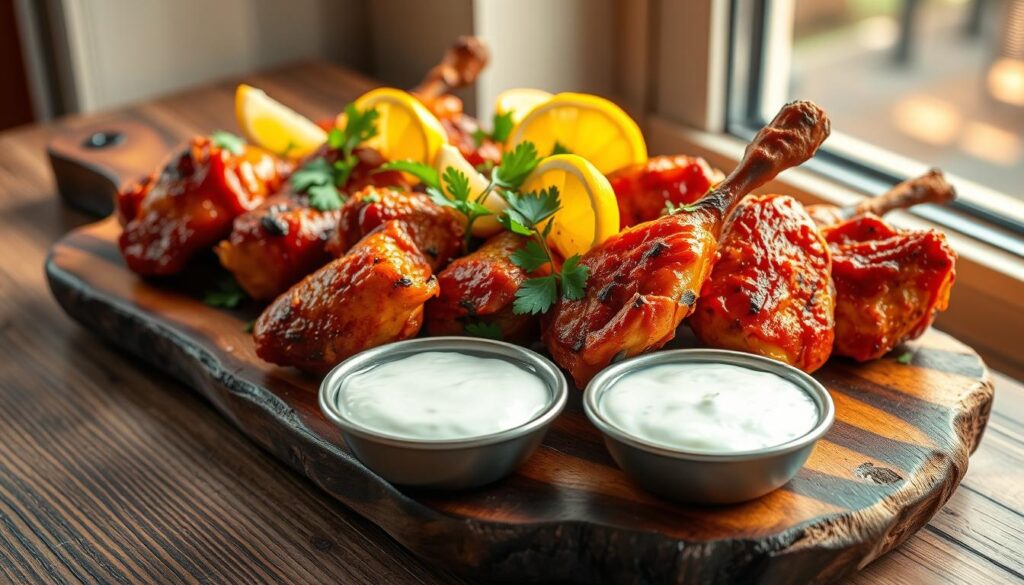
Ideal Sides to Complement Tandoori Chicken
Pair your tandoori chicken meal with these ideal sides to elevate your dining experience:
- Fresh Salads: A crisp cucumber and tomato salad adds freshness and balances the spices.
- Raita: This yogurt-based side dish helps to cool down the palate with its creamy texture.
- Rice: Fluffy basmati rice or fragrant pulao complements the robust flavors of the chicken.
With each leg quarter weighing approximately 226 grams, tandoori chicken remains a nutritious option. Nutrition facts for a typical serving include:
| Nutrient | Amount |
|---|---|
| Calories | 376 kcal |
| Protein | 27 g |
| Total Fat | 28 g |
| Saturated Fat | 6 g |
| Cholesterol | 97 mg |
| Sodium | 264 mg |
| Potassium | 305 mg |
| Carbohydrates | 2 g |
| Fiber | 0.5 g |
| Sugar | 1 g |
These details highlight why tandoori chicken stands out as a favorite in Indian cuisine, making it a must-try dish for anyone exploring authentic Indian food.
9. Pani Puri: The Street Food Favorite
Pani puri, a beloved indian street snack, is known for its delightful blend of flavors and textures. This dish consists of hollow, crispy puris filled with a variety of ingredients, often including spiced water, potatoes, and chickpeas. Whether enjoyed from a roadside vendor or prepared at home, pani puri is sure to impress your taste buds with every bite. Let’s explore the key components and discover how you can create your own pani puri recipe at home.
Understanding the Components
The magic of pani puri lies in its simple yet flavorful ingredients. Typically, the puris are made from semolina or refined flour, deep-fried until they are light and crispy. The filling often features mashed potatoes combined with chickpeas, adding both protein and fiber to the delightful mix. What truly sets this dish apart is the flavored water, or pani, which can vary significantly in taste.
| Types of Pani | Main Ingredients | Flavor Profile |
|---|---|---|
| Khatta Meetha Pani | Tamarind, Jaggery | Sweet and tangy |
| Theeka Pani | Mint, Coriander, Green Chillies | Spicy and refreshing |
| Bangarapet Pani | Unique spices | Spicy with a kick |
How to Make Pani Puri at Home
Preparing pani puri at home can be an exciting endeavor. Start with the puris, rolling out the dough into small circles and deep-frying them until they puff. Meanwhile, create the pani by blending fresh herbs and spices with water, adjusting the flavors to your liking. A classic pani puri recipe may include ingredients like:
- Fresh cilantro and mint
- Tamarind paste
- Chaat masala
- Basmati rice for added texture
Once the puris are ready, assemble by filling them with your prepared pani, potatoes, and chickpeas. Customize with various toppings, such as diced onions or sev, for an enhanced experience. The unique combinations not only offer traditional flavors but also allow for innovative twists, making each serving special. Enjoy your homemade pani puri as a vibrant appetizer or a fun snack at gatherings!

10. Gulab Jamun: The Sweet Finish
Gulab Jamun is one of the most cherished popular indian desserts, known for its rich flavor and indulgent sweetness. Made from fried dough balls that soak in a fragrant sugar syrup, this dessert is often the perfect end to a lavish Indian meal. You will find it gracing tables during festivals and special occasions, delighting all who taste it.
The Making of This Iconic Dessert
The gulab jamun recipe is straightforward, yet it delivers delightful results. Begin by preparing the sugar syrup using equal parts of sugar and water. Heat it until it reaches a gentle simmer. Cooking the syrup at approximately 61°C (142°F) for 4-5 minutes achieves the desired consistency. For the dough, you’ll require 200g of skimmed milk powder, 2 1/2 teaspoons of baking powder, and 1 1/2 tablespoons of ghee. Mix in 2 teaspoons of lemon juice, 5 ground green cardamom pods, 1/8 teaspoon of salt, and a handful of saffron strands for a fragrant touch.
Once the dough is ready, let it rest for about 10 minutes before shaping it into balls, each weighing around 15 grams. Deep fry these in 1 liter of oil, initially heated to 100°C (212°F), and maintain the temperature until they float to the top. Frying should last about 7-8 minutes until they achieve a golden brown hue. For best results, soak the fried balls in warm sugar syrup for 6-8 hours. This allows the gulab jamun to absorb the syrup fully, transforming into heavenly bites of sweetness.
Variations You Might Want to Try
While the classic gulab jamun recipe is always a winner, there are several fun variations to consider. Adding flavors such as rose water, or saffron enhances the syrup’s richness. For a twist, some recipes incorporate chocolate or coconut. Feel free to experiment with fillings like khoya for an exquisite culinary experience. The versatility of this dessert ensures it can be tailored to suit your palate.
| Ingredient | Quantity |
|---|---|
| Skimmed Milk Powder | 200g |
| Granulated Sugar | 600g |
| Water | 600ml |
| Saffron Strands | 15-20 |
| Ghee | 1 1/2 tbsp |
| Baking Powder | 2 1/2 tsp |
| Lemon Juice | 2 tsp |
| Green Cardamom Pods | 5 |
| Salt | 1/8 tsp |

Conclusion: Embracing Indian Cuisine
Indian cuisine offers a captivating journey through rich, authentic flavors and vibrant textures. As you explore Indian cuisine, you’ll discover the significant evolution driven by cultural and historical influences. The spice trade established India as a culinary hub, enriching the cuisine with new ingredients like chili peppers, which have become staples in many dishes.
The Mughal Empire profoundly influenced Northern Indian cuisine with its rich gravies and biryanis, while the British Raj introduced tea and baking techniques that reshaped cooking practices across the country. You can find diverse regional cuisines, with the South known for coconut-based dishes and the North favoring hearty wheat-based meals. Migration within India has fostered hybrid dishes that showcase the intermingling of these regional tastes.
As climate change and agricultural trends prompt adaptations, traditional recipes have undergone transformations based on availability. Globalization has also played a role, giving rise to fusion cuisines like Indo-Chinese and British-Indian dishes. Urban areas have witnessed the Indianization of global cuisines, allowing you to experience Italian or Mexican dishes with an Indian twist.
Modern culinary innovations, from molecular gastronomy to health-conscious adaptations, further enhance the dining experience. The popularity of celebrity chefs has made Indian recipes more accessible, encouraging many to embrace this diverse cuisine. With over four million recipes prepared daily and an increasing emphasis on sustainability and local sourcing, the future of Indian cuisine appears promising.
While traditional cooking techniques like slow cooking and marinating continue to develop those deep, rich flavors, the emergence of plant-based diets has inspired a reinvention of classic recipes. As you dine, whether in a family-style setting or a modern restaurant, the warmth and community spirit of Indian dining will always be at the forefront.
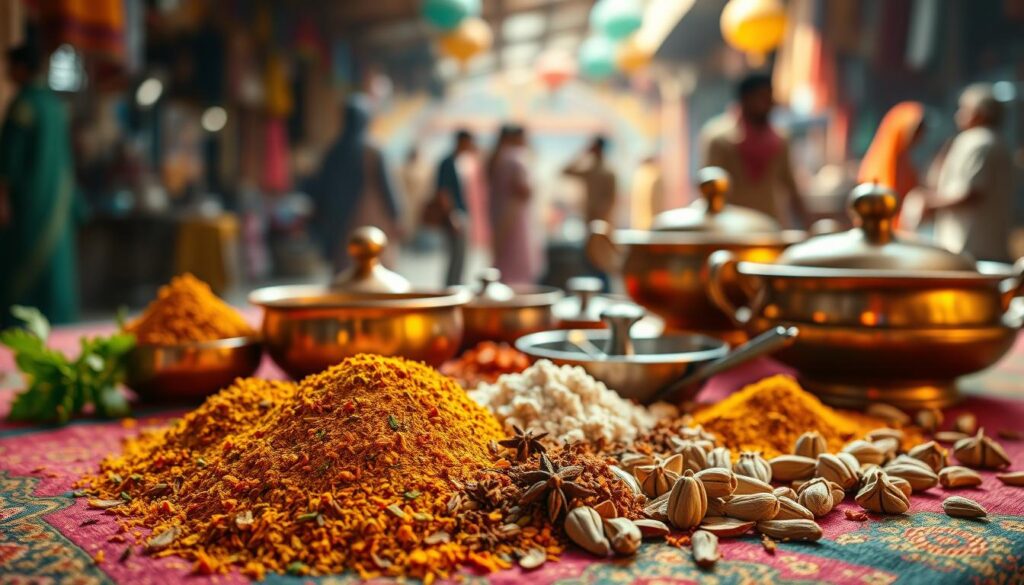
Your Journey into Indian Flavors Begins Here
Having explored the ten must-try delights of Indian cuisine, you now stand on the threshold of a vibrant culinary experience. The adventure doesn’t end here; it’s merely the beginning. With countless regional dishes and traditional recipes waiting for you, there is plenty to discover. Whether you choose to experiment with spices at home or venture into local Indian restaurants, each approach opens the door to a deeper appreciation of this fascinating food culture.
As you dive deeper into your Indian food adventure, consider trying your hand at preparing vegetarian dishes that beautifully represent India’s diverse culinary landscape. With approximately 30% of India’s population being vegetarian, you’ll find an abundance of flavorful options like palak paneer and baingan bharta that showcase both creativity and authenticity. The rich variety of spices used in Indian cooking—from cumin and coriander to turmeric and cardamom—offers a chance to elevate your dishes and impress your friends and family.
Lastly, don’t forget the communal aspect of Indian meals. Sharing food is an integral part of Indian culture, symbolizing unity and joy. Engage in the tradition of communal dining during festivals or special gatherings, where the colors, aromas, and tastes of Indian cuisine come alive. As you embrace this culinary journey, you’ll not only satisfy your palate but also enrich your understanding of Indian culture and its rich heritage.
